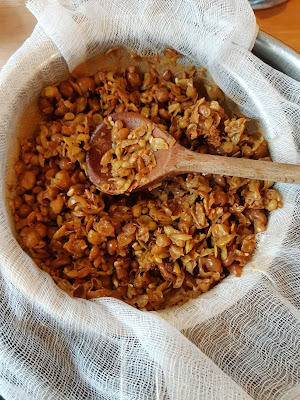The first step in making wine is planting the vines and tending to them for five years before expecting a harvest. You lose your first measly harvest to the birds because you decided to wait one more day for the sugar to increase around year 4. You get a small but encouraging harvest at year 5. Now finally in year 6, there are plenty of grapes because having learned your lesson, you've protected them from the birds using raptor kites flying above, shiny CDs hanging among the grape clusters, a scarecrow, and a metal heron standing tall below. Perhaps you wrap them in mesh bags or cover the whole vineyard with mesh. Finally, the day comes when they test ripe enough measured with a refractometer. We have finally experienced that pleasure.
This is my new list of steps to making wine so I don't have to start from scratch next year. We have decided not to use Campden tablets or any chemicals in the process. We will use them only for the sterilisation of the equipment.
- Harvest grapes - we found that needle nose anvil shears or Cultivation Scissors are the handiest
- Rinse grapes and let them dry and sterilize all equipment
- Press grapes to release juice called must (by hand, by Moulin, or by fruit press)
- Measure specific gravity (SG)
- Pour some juice through a sieve into the testing cylinder
- Drop hydrometer into the liquid so it floats
- Read the SG
- Pour red crushed grapes into a sterilised brewing bucket
- Cover the bucket and leave for 24 hours
- Make yeast starter
- Boil water and allow to cool
- Dissolve 1 tbsp sugar in 1/2 cup of water
- Add wine yeast to the sugar solution
- Cover and allow to bubble for about an hour
- If SG <1.010 consider adding sugar. Make sugar syrup with filtered boiled water to compensate for SG (see next post for calculations)
- Add sugar syrup and yeast starter to grapes
- Cover the bucket and leave at room temperature (or on a heated pad if necessary)
- Stir bucket daily, pressing grapes down into the liquid as they rise
- After 6 days, pass juice through muslin cloth in a sieve - squeeze all juice out of grapes
- Measure SG
- Pour the juice into sterilized demijohns - fill as much as possible to reduce contact with air.
- Dissolve sugar in cool boiled water to compensate for SG (see next post)
- Add sugar water to the wine in the demijohns and set aside at room temperature to settle and ferment for several weeks.
- Use the plastic tube to siphon the wine into clean glass secondary fermentation containers. The purpose is to separate the wine from the sediment as it ferments. Called racking.
- Continue racking for 2-3 months until the wine runs clear.
- Run the wine into bottles using cleaned plastic tubing, leaving space for cork and a half-inch more
- Insert corks or screw caps
- Store upright for the first three days
- After 3 days, store bottles on their sides ideally at 55 degrees F (13 degrees C).
- White wine ready to drink after 6 months. Red wine should be aged at least 1 year.

















